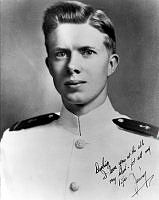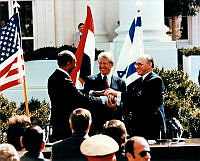Rubenstein Center Scholarship
Presidents and the Hey Day of Horse Racing in the Federal City

President Richard Nixon at the Kentucky Derby, 1969.
© Churchill Downs Incorporated/Kinetic CorporationPresident Richard M. Nixon was the first sitting president to attend the Kentucky Derby on May 3, 1969. In his party that day were Mrs. Nixon and then Governor and Mrs. Ronald Reagan, all rooting for the winner, California-based Majestic Prince. Presidential parties attending horse races was once a common occurrence in the colonial period and early republic. Even before the seat of national government moved from Philadelphia to the new capital of Washington, D.C. in 1800, horse racing was a popular and well-established sport in the region. George Washington, statesman, general, and president, embodied this generation of early Americans who found sport and pleasure in horse racing. Washington regularly attended and wagered on horse races throughout his life at meetings in Annapolis, Alexandria, and Williamsburg.1
In 1798, the same year that stonemasons finished erecting the walls of the President’s House and whitewashed the building to seal the stone from the elements, a mile track was laid out which extended from the rear of what is now the site of Decatur House at H Street and Jackson Place, crossing Seventeenth Street and Pennsylvania Avenue to Twentieth Street. “Carriage folk” looked on from the infield and standees ringed the outside of the course. The inaugural meeting featured a 500 guinea match race between John Tayloe III’s Lamplighter against General Charles Ridgeley’s Cincinnatus, contested in three heats and won by Tayloe’s entry, a son of the imported English-bred stallion Medley.
The course that occupied land just west of the President’s House, largely on the site of today’s Eisenhower Executive Office Building, was short-lived, as it stood in the path of the implementation of Pierre Charles L’Enfant’s 1791 city plan. The Washington Jockey Club, under John Tayloe’s leadership, laid out a mile oval track near Meridian Hill just south of Columbia Road between Fourteenth and Sixteenth Streets. Meetings were held regularly until the invasion of the British forces in 1814 during the War of 1812. Although a fall meeting was held just two months after the occupation, there was a long period of inactivity until the revival of a golden age of racing in 1822.2

A portrait of Washington on horseback receiving a salute on the field at Trenton, ca. 1860.
Over the next two decades what became known officially as the National Race Course, located just outside the Washington city boundary two miles north of the White House near Meridian Hill, vied with the best tracks in the nation in terms of patronage and the quality of the racing. Thomas Jefferson and James and Dolley Madison rarely missed the meets. The best horses in the country competed there into the 1840s, and the Jockey Club dinner and ball, a highlight of the social season, concluded the meeting.3
A nostalgic column in the Washington Post in 1891 recalled the “Sports of Early Days,” noting that Presidents Andrew Jackson, Martin Van Buren, John Tyler, and James K. Polk, along with cabinet officials, foreign diplomats, senators, and congressmen regularly attended the races. Joined by the landed gentry of Maryland and Virginia, the city’s elite traveled by carriage to the “green hills and dales overlooking the Capital, and being bewitched by the lovely women, wines of rare vintage, and magnificent thoroughbreds, our public men drank from the cup of the blissful and enchanting elixir of the sporting life.”4

Among the noted horses who ran on the National Course between 1800 and 1840 were American Eclipse, Sir Archy, Boston and Fashion, all inductees of the Racing Hall of Fame.
One of the most renowned owners and trainers at the National Course was President Andrew Jackson, who built a new stable at the White House in 1834 (razed in 1857 to make way for the south wing of the Treasury Department). Jackson stabled his racehorses in a new 10-stall brick and stone structure complete with a brick-paved courtyard shaded by elm trees planted by Irish gardener James Maher. He brought African American jockeys and grooms to ride and care for his racehorses and operated a racing stable from the White House. It was an open secret that Jackson entered and gambled on runners at courses in Washington, Alexandria, and Baltimore in the name of his nephew and private secretary Andrew J. Donelson.5

This 1853 equestrian statue of General Andrew Jackson by sculptor Clark Mills captures the president’s skill as a horseman. Located at the center of Lafayette Square just north of the White House, it was the first equestrian statue cast in the United States.
White House Historical AssociationUlysses S. Grant was the last president actively involved in horse racing and the rise in the popularity of harness racing in America after the Civil War was evident in the presidential campaign of 1868. Grant persuaded Robert Bonner, the owner of the legendary trotter Dexter, to allow him for a spin. Currier and Ives captured the scene in a popular 1868 print of the legendary horse at full speed with Grant holding the reins. Grant was an avid horseman and loved to take a light carriage out of the White House stables onto the streets of Washington, occasionally racing his neighbor on Lafayette Square, General Edward Beale, the wealthy adventurer and California rancher who owned Decatur House. Grant appointed Beale ambassador to Austria-Hungary in 1876-1877 and they remained lifelong friends. The president spent weekend afternoons with General Beale at his farm in Hyattsville, Maryland. Beale bred and trained Standard breds at Ash Hill farm for the races at Brightwood Park in the District of Columbia.6
Since the Grant administration most presidents have stayed away from the racetrack while in office due to the opposition to gambling or its associations with the trappings of royalty. However, horse racing has continued to have White House connections. Woodrow Wilson attended the reopening of Longchamps in Paris after World War I during the peace talks and president-elect Herbert Hoover had a race named in his honor, the “Hoover Stakes,” in Brazil while on a trip to Latin America.7 President Franklin D. Roosevelt listened intently to the radio for the live call of the great match race between Seabiscuit and War Admiral at Pimlico in 1938. Harry S. Truman attended the 1948 Derby. Dwight D. Eisenhower, after his term in office, presented the Belmont Cup to the winning connections at the 1961 Belmont Stakes.8

Presidential Candidate U.S. Grant takes the reins of renowned trotter Dexter with owner Robert Bonner, 1868.
Richard Nixon enjoyed the races and as vice-president presented trophies at the Laurel and Bowie races and attended the Derby as a candidate in 1967 and president in 1969. Jimmy, Rosalynn and Amy Carter; George and Barbara Bush; and Gerald Ford were all in attendance at Churchill Downs in 1983. George W. Bush attended the Kentucky Derby while a candidate for president in 2000.9 President Bush also invited the winning Derby jockey Calvin Borel to a 2007 state dinner for Queen Elizabeth II, a renowned racing fan and owner and breeder of racehorses.
In 2014, the Kentucky Derby drew more than 16 million television viewers, hardly a Super Bowl number, but a reminder of the passion for horse racing that early presidents held when it was, by far, the most popular sport in America.10

A conjectural sketch of the Jackson stable by artist Peter Waddell, 2007.






























































